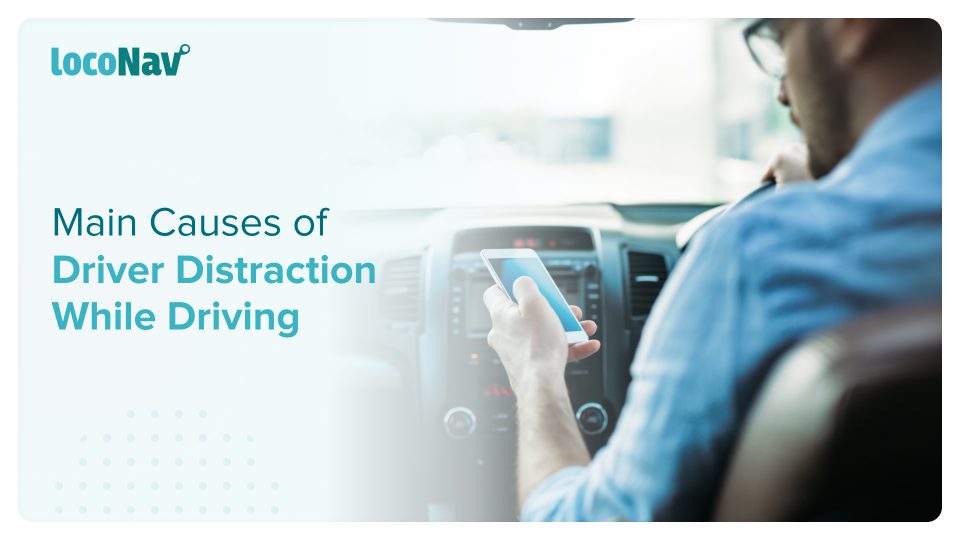

As a fleet manager, one of your main objectives is the safety of your drivers, and preventing distracted driving is an important part of assuring your drivers’ safety on the road. Driving while distracted is the single most common cause of vehicle collisions, which not only increases maintenance costs and compensation but is also the top cause of driver accidents and fatalities.
Driving safely necessitates training programs and attentiveness while on the road. And, with drivers already dealing with the challenges of working long hours, frequent stop-and-go deliveries, driving at night, and traveling great distances, it can be tough to keep a constant eye on the road. It can be tempting for drivers to spend long hours in the taxi distracted by technological devices and smartphones.
In this blog, we will discuss what distracted driving, the types of distracted driving, and the 5 common causes of distracted driving:
What is Distracted Driving?
Distracted driving occurs when a driver’s attention is diverted from the road for any purpose and for any period of time—even a few seconds. There are various forms of diversions that drivers may encounter, but there are four major categories.
Types of Distracted Driving
There are 4 main types of distractions a driver might come across while driving:
- Manual
A manual distraction is defined as any activity that leads a driver’s hands to leave the steering wheel. These include multitasking, such as eating, using a cellphone, or changing the station on the vehicle radio while driving and operating their vehicle.
- Cognitive
A cognitive distraction happens when a driver’s attention is diverted from the activity at hand. Cognitive distraction can vary from having a poor day that makes it challenging to concentrate to participating in a phone call a hands-free phone call—while driving.
- Visual
A visual distraction is something that causes a driver’s attention to be diverted from the road. Texting while driving or looking for something in the vehicle are examples of common distractions.
- Auditory
Auditory distractions occur when a noise or sound from within or outside the car draws the driver’s focus away from the road. This includes passengers conversing noisily, horns blaring, or a mobile device ringing.
Common Causes of Distracted Driving:
- Talking/texting on the phone
The practice persists despite various awareness campaigns regarding the dangers of texting and driving. A few seconds with your attention off the road while texting or checking anything online on your smartphone could be the final mistake you make.
- Adjusting car controls
Scanning the radio or constantly changing your car’s temperature may appear to be pointless tasks, but they can take your attention away from the road for longer than you think. Set your songs and temperature before you start driving. It is frequently necessary to adjust your vehicle’s rearview and outside mirrors, roll up the windows, adjust your seat, or check a navigation system.
- Reaching for something in the vehicle
It may not take long to change a CD or grab a package of breath mints, but if you grab for something, one hand is off the steering and your eyes are likely not on the road. Usually, whatever you’re reaching for can wait until the automobile is stationary.
- Rubbernecking
It’s difficult not to glance when you pass a crash scene, spot a creature on the side of the road, or notice anything unusual along your journey. Although looking is unavoidable, diverting your eye off the ball, even if you decrease your speed, increases the danger of an accident.
- Smoking
Aside from the well-known health dangers of smoking, smoking while driving means one hand is usually off the wheel. Cigarette ashes or cinders that fall cause extra hazards. If you can’t quit the habit, at least get it out of your system.
Tips to Avoid Distractions While Driving
Fortunately, there are numerous solutions available to assist distracted drivers. Continuous feedback is essential for improving driving habits. Drivers and fleet managers have access to a wealth of data, including overspeeding events and harsh braking, but the device cannot provide the complete understanding that a dashcam can: particularly, what occurred right before, during, and after an incident, both in aspects of in-cab driver behavior and external factors over and above their control.
The LocoNav’s dual-facing camera is always active, but only a harsh driving event will cause a video to be automatically shared to the internet platform. Dashcams are especially useful for developing coaching programs, especially if the dashcam is equipped with features that can inform and educate the driver in their cab in real-time.
While it’s normal for drivers to be wary of being visually monitored, once they realize that dashcams are proactive – and there to protect them from responsibility, harm, and death – coming on board will be a no-brainer. Distracted driving can be avoided. You and your fleet can increase safety every day if the correct tools are in place, such as LocoNav’s dash cams and fleet management platform.